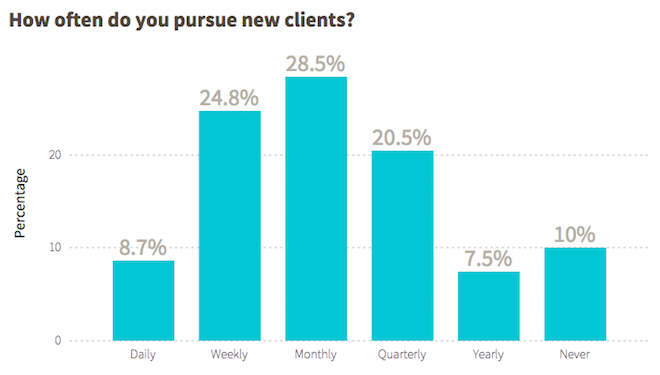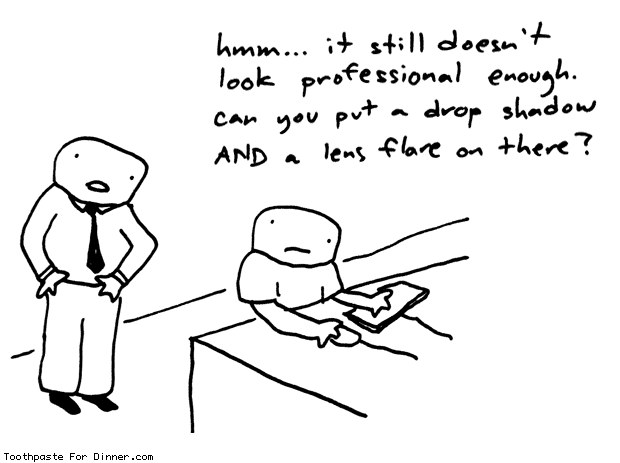Psssttt...

Ready to find high-paying clients and build a profitable business?
Get your free copy of Win More Clients, a 20+ page eBook that shows you how to get paid more and the secret sauce you need to create a sustainable freelance business
There is only one thing us freelancers have to do time and time again (apart from the actual work, duh!), and that’s land new clients.
It’s almost a full-time job in itself, right?
But there’s so much information out there about how you should get clients, where to find them, and what you need to do to seal the deal, that it’s difficult to even know where to start.

This freelancer report shows that the majority of freelancers pursue new clients every month.
I’m all about being proactive. Rather than wait for the work to come to you, it’s much easier (especially when you’re starting out) to go out and find the work yourself.
That doesn’t mean trawling through content mills or job boards – oh, no – it means reaching out to clients that you want to work with via what we in the industry like to call a pitch.
Now, that word brings a lot of people out in a cold sweat, myself included.
Pitching has these horrible connotations of selling yourself, stumbling around your words, and generally trying to bribe people into hiring you with a desperate whiny voice.
It’s not a good look.
But, in actual fact, pitching potential clients is what got me to where I am today, and I’m willing to bet that most of those awesome freelancers out there that are doing their own thing with amazing clients started out pitching, too.
Yes, it’s scary. But it’s also necessary.
So if you’re still trying to get rid of those cold sweats, let me help ease the pain by busting some persistent myths that people have about pitching.
Don’t forget to grab your free download of a pitch anatomy! Get it below!

-
It’s All About Quantity
Yes, safety in numbers is a thing, even when it comes to pitching.
I mean, the odds are more in your favour the more pitches you send out. But you’ll get as many responses by sending out 100 crappy pitches as you would five crappy pitches – and that’s none, if you hadn’t figured it out.
In the first instance, you shouldn’t be worrying how many brands you’ve sent your pitch to. You should be worrying about whether your pitch is converting.
You’ve sent out fifty pitches in 2 hours? Impressive! But how many responses have you had?
A pitch needs to hit all the right spots in order to convert – and that’s the ultimate aim of it. You aren’t sending them out for fun, you’re sending them out to land work and the best way to measure the ROI on that is the conversion rate.
A pitch needs to hit all the right spots to convert
I’ve got plenty of cold email tips for you, but my biggest one for you RIGHT NOW is to take a long hard look at the meat of it.
Are you just sending them out to get your numbers up? Or are you really crafting each one with the main aim of converting the particular client you’re sending it out to?
2. Cold Emails Are Annoying
People’s inboxes are sacred, we get it. But landing in someone’s sacred space is the best (and sometimes only) way to be heard.
When you think about it this way, it’s easy to shy away from sending any pitches because you don’t want to annoy anyone.
“Surely the client is just going to be pissed off with me for emailing them, so I might as well not email them in the first place.”
You’d be amazed at how many freelancers think like this.
But as soon as you start thinking your emails are annoying, they’re going to be annoying. You’re going to subconsciously start apologising to your lead and you’re going to write in a way that doesn’t inspire confidence.
Yes, pitching is scary, but you can make it ten times less scary by acknowledging that you have something of value to offer and basing your pitch around that.
No apologies.
No shying away from people because you don’t want to annoy them.
Just pure, unadulterated value.
When you start thinking like that, those potential clients will too. And guess what? That’s more likely to get you hired.
3. Being Professional Means Big Words
Pitching is all about using your words. I mean, there are probably some people out there sending out video pitches (which is an awesome idea), but for the most part we can assume that a pitch equals a written email.
Something takes over when people start pitching, and they go from literate human beings with a conversational flow to awkward robots that thrive on using the longest word in the dictionary they can find (regardless of whether it makes sense or not).

Just because you’re pitching someone in the professional realm, doesn’t mean you have to go all stuffy.
News flash: professional doesn’t mean dull and boring with a hearty side dose of jargon.
Instead, write as if you are talking. Go back through your pitch and swiftly erase any long words that stilt the flow of your piece. You’ll find it much easier to create connections with potential clients this way – trust me.

The Number One Thing Most Freelancers Ignore When It Comes to Pitching
Now we’ve boiled down the three biggest myths when it comes to pitching, let’s pour a little more salt on the wound and talk about the one thing you’re probably doing wrong.
The last myth I mentioned was thinking that professional equals a monocle and a put-on posh voice. But in reality, the more human you are, the more likely you are to build a rapport with a client.
And guess what? Even in this digitally-led age, people still crave connections with other humans. Clients don’t want to hire robots, they want to hire real people who understand their problems and can help them.
So what’s the number one thing freelancers ignore when it comes to pitching?
Being human.
It’s as simple as that. Just speak (or write) to potential clients as if you were at a bar with them. Tell them what you do and how you can help them do it but, most importantly, focus on them. Tell them how your services will improve their business or their life.
As humans, we love it when people put the emphasis on us.
How many times have you sat there bored out of your mind in a conversation because someone is rabbiting on about themselves? Too many to count, right?
And how many times have you left a conversation feeling good about yourself because your conversational partner asked questions, took an interest in you, and made an effort to help you out?
The online world is no different to real life.
People still want to talk to people – it’s why those horrible spammy emails about SEO rankings go unread and trashed. These are the kind of pitches you’re up against, so by simply writing like the human being you are, you’re already vastly improving your chances of getting a response and getting hired.
Tell me, are you guilty of believing any of these myths?







I always worry that I’m going to annoy people. Or that my portfolio isn’t good enough – most of my work is ghostwritten so I can’t direct them to the best stuff!
Ah I’m the same – I always think I’m going to annoy someone! I thought I’d get over it, but I still sometimes feel a physical cringe when I think about someone reading my email and slinging it straight into the trash!
I feel you on the ghostwritten stuff, too. A lot of my best work doesn’t have my name on it, but if you’ve got even just a few non-ghostwritten pieces that are the same quality that should be enough!
Great advice as always, especially regarding the quantity. Better 5 well directed emails than 100 to anyone. Thanks Lizzie
Thanks so much, Lindsay!
Great post, Lizzie! I completely agree — the biggest thing holding freelancers back from cold pitching is fear. Fear of rejection and fear of making people angry.
You had a great point: remaining human in your pitches can lead to success. And hopefully not making angry!
Thanks for coming up with this post!
Brittney
Yes, fear is such a HUGE barrier! As freelancers, it often feels like we’re putting ourselves out there rather than just our work or services, so a rejection is like a double whammy – not only is the client rejecting our work, it also feels like they’re rejecting us as people, too.
Great advice – thank you so much for sharing!
Kate
Thanks, Kate!
Really good advice.
I am always hesitant to ‘pitch’; I think it because I have a fear of rejection and mainly I don’t want to annoy others.
What about asking if existing clients can refer you? Then the leads would be warmer and the acceptance rate higher?
Leo Tat recently posted…23 Turmeric Curcumin Health Benefits and Uses
Yes, fear of rejection holds so many freelancers back! Asking for referrals is a great idea. The leads are warmer, and you’re having someone vouch for you, which is ten times more effective than reaching out to a complete stranger.
Wow – I love this.
I’m just starting my freelancing journey, although I’ve been hanging out in freelancing groups & subreddits for most of 2017. And… number 1 was SERIOUSLY the golden piece of advice I needed to read.
Honestly. You’re right – I read tons of “advice” aka comments that say people aren’t pitching enough. But what you’ve said about making sure your pitch hits the right spot – THIS IS WHAT PEOPLE NEED TO READ!
Thanks so much, Krista!
Pitching a lot is great…. IF (and only IF!) you’re pitch is saying the right thing. It’s completely pointless and a big waste of time if you’re blasting out a pitch to hundreds of companies that’s missing the mark.
So glad this was helpful for you!